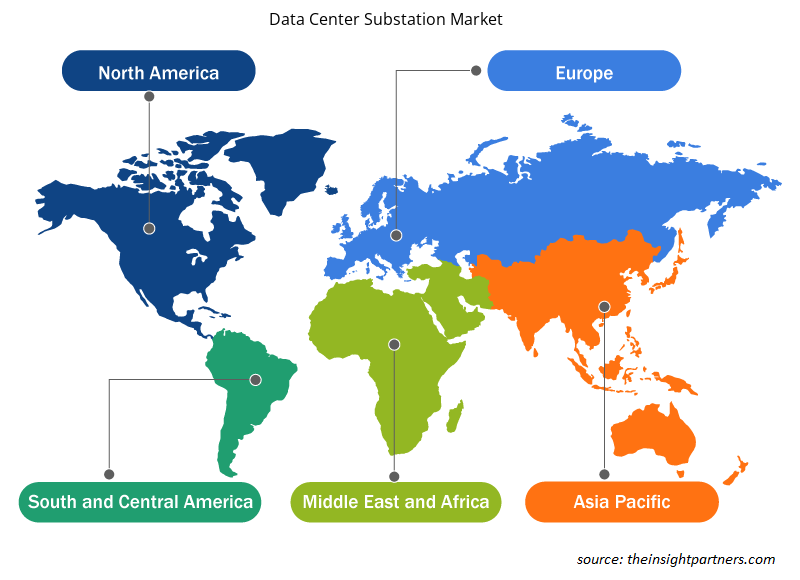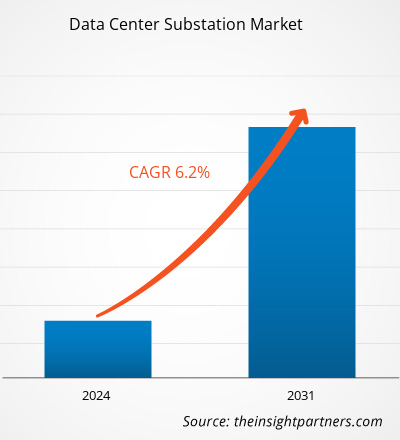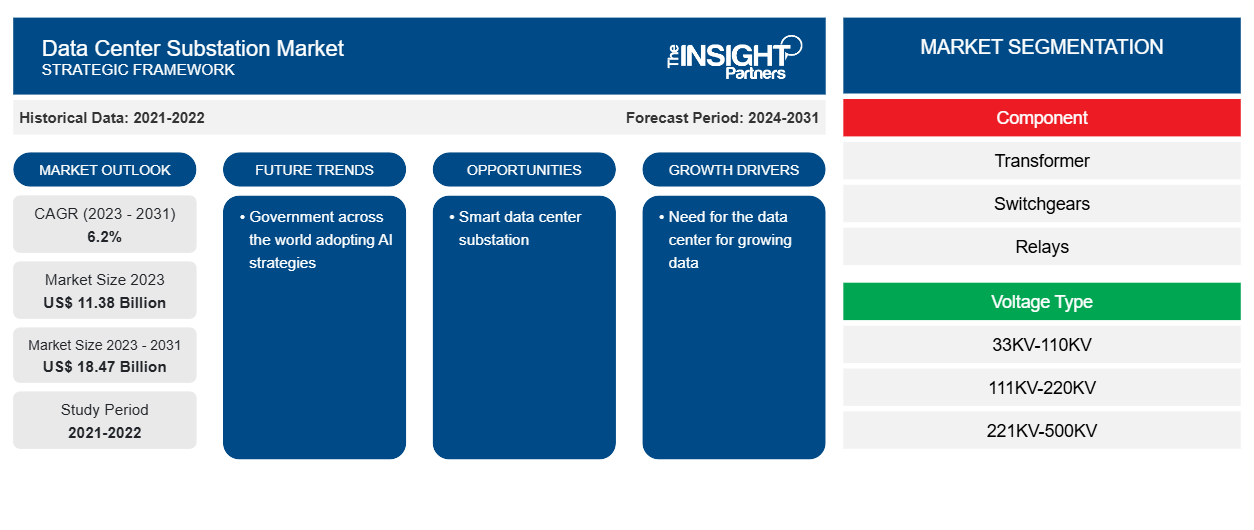Der Markt für Umspannwerke in Rechenzentren soll von 11,38 Milliarden US-Dollar im Jahr 2023 auf 18,47 Milliarden US-Dollar im Jahr 2031 anwachsen. Der Markt soll zwischen 2023 und 2031 eine durchschnittliche jährliche Wachstumsrate (CAGR) von 6,2 % verzeichnen. Das weltweite Wachstum von Rechenzentren und der Bedarf an einer effizienten, reibungslosen und zuverlässigen Stromversorgung der Rechenzentren dürften weiterhin die wichtigsten Trends auf dem Markt bleiben.
Marktanalyse für Umspannwerke in Rechenzentren
Die wachsende Zahl von Rechenzentren weltweit treibt den Bedarf an effizienter Stromversorgung voran, was den Markt für Umspannwerke für Rechenzentren weiter ankurbelt. Unternehmen, die ihre Geschäfte weltweit ausweiten, eröffnen eigene Rechenzentren oder entscheiden sich für Colocation-Dienste, was den Bedarf an Rechenzentren weiter ankurbelt. Die wachsende Datenmenge erzeugt den Bedarf an Speichermöglichkeiten, wo sie verarbeitet und analysiert werden können, was den Bedarf an Rechenzentren weiter ankurbelt. Der steigende Bedarf an Rechenzentren treibt also den Markt für Umspannwerke für Rechenzentren an, um eine effiziente Stromversorgung während des Baus und Betriebs des Rechenzentrums zu gewährleisten.
Marktübersicht für Umspannwerke für Rechenzentren
Ein Umspannwerk für Rechenzentren ist eine Einrichtung, die eine wichtige Rolle im Stromnetz spielt und Energie von der Produktion zum Verbrauch überträgt. Das Umspannwerk hilft, die Geräte vor Fehlern oder Kurzschlüssen zu schützen und Schäden an den Stromleitungen und Geräten zu vermeiden. Anbieter von Rechenzentren wenden sich an den Energieversorger, um ein Umspannwerk auf ihrem Campus zu errichten oder eines zu bauen und es zum Rechenzentrum zu liefern.
Passen Sie diesen Bericht Ihren Anforderungen an
Sie erhalten kostenlose Anpassungen an jedem Bericht, einschließlich Teilen dieses Berichts oder einer Analyse auf Länderebene, eines Excel-Datenpakets sowie tolle Angebote und Rabatte für Start-ups und Universitäten.
-
Holen Sie sich die wichtigsten Markttrends aus diesem Bericht.Dieses KOSTENLOSE Beispiel umfasst eine Datenanalyse von Markttrends bis hin zu Schätzungen und Prognosen.
Treiber und Chancen auf dem Markt für Umspannwerke für Rechenzentren
Bedarf an Rechenzentren für wachsende Datenmengen zur Förderung des Marktes
Die Daten werden in einem immer schnelleren Tempo generiert. Die zunehmende Verbreitung des Internets hat die Datengenerierung vorangetrieben. Unternehmen auf der ganzen Welt verlassen sich auf datengesteuerte strategische Planung für ein effizientes Geschäftswachstum. Darüber hinaus generiert das IoT eine riesige Menge an Daten, die in Echtzeit verarbeitet, gespeichert und analysiert werden müssen. Die Einführung von 5G wird das Datenverkehrsvolumen voraussichtlich deutlich erhöhen, da 5G viel höhere Daten und geringere Latenzzeiten bietet als 4G und andere Netzwerke. Laut den Cisco-Berichten wird 5G bis 2023 mehr als 10 % der weltweiten Mobilfunkverbindungen unterstützen, mit einer durchschnittlichen Geschwindigkeit von 575 Mbit/s. Das ist 13-mal schneller als die durchschnittliche Mobilfunkverbindung heute. Aufgrund des erhöhten Datenverkehrs werden Unternehmen und Betriebe nach einem Standort suchen, an dem sie ihre Daten effizienter und zuverlässiger speichern, verarbeiten und verteilen können, was den Bedarf an Rechenzentrumsanbietern erhöht. Um das Stromnetz eines Rechenzentrums effektiv zu verwalten, wächst daher die Nachfrage nach Rechenzentrumsunterstationen.fuelled the generation of data. Businesses all over the world are relying on data-driven strategic planning for efficient business growth. In addition, IoT generates a huge number of data that needs to be processed, stored and analyzed in real-time. The deployment of 5G is expected to significantly increase the volume of data traffic, as 5G offers much higher data and lower latency than the 4G and other networks. According to the Cisco reports, 5G will support more than 10% of the world's mobile connections by 2023, with an average speed of 575 Mbps. That's 13 times faster than the average mobile connection today. Due to increased data traffic, businesses and enterprises will seek a location to store, process and distribute their data more efficiently and reliably, contributing to the need for data center providers. Thus, to manage the power grid of a data center effectively, the demand for data center substations is growing.
Intelligente Umspannstation für Rechenzentren
Die Regierungen verschiedener Länder überwachen den Bau von Rechenzentren genau und sorgen bei der Entwicklung und Arbeit an Rechenzentren für Nachhaltigkeit. Die Regierung konzentriert sich darauf, ihren CO2-Fußabdruck zu reduzieren und die Probleme zu lösen, die sich aus den energieintensiven Anlagen ergeben. Daher konzentrieren sich die Marktteilnehmer auf den Bau intelligenter Umspannwerkslösungen für Rechenzentren, um die Rechenzentrumsbranche effektiv zu fördern. Beispielsweise bietet ABB intelligente Umspannwerke für Rechenzentren an, um den CO2-Fußabdruck und den Immobilienfußabdruck dieser Anlagen zu reduzieren. Durch die Verwendung intelligenter modularer Komponenten konnte das Unternehmen die Anzahl der Kupfersteuerkabel um über 50 % reduzieren. Der Bau solcher intelligenter Lösungen wird also die Rechenzentrumsbranche fördern und die Nachfrage nach einem effizienten Markt für Umspannwerke für Rechenzentren steigern.
Segmentierungsanalyse des Marktberichts für Umspannwerke im Rechenzentrum
Wichtige Segmente, die zur Ableitung der Marktanalyse für Umspannwerke in Rechenzentren beigetragen haben, sind Komponente und Spannungstyp.
- Basierend auf den Komponenten ist der Markt für Umspannwerke für Rechenzentren in Transformatoren, Schaltanlagen, Relais und andere unterteilt. Das Segment Schaltanlagen hatte im Jahr 2023 den größten Marktanteil.
- Nach Spannungsart ist der Markt in 33 KV–110 KV, 111 KV–220 KV, 221 KV–500 KV und über 500 KV segmentiert. Der Bereich über 500 KV dürfte im Prognosezeitraum mit einer signifikanten durchschnittlichen jährlichen Wachstumsrate wachsen.
Marktanteilsanalyse für Umspannwerke in Rechenzentren nach geografischer Lage
Der geografische Umfang des Marktberichts für Umspannwerke in Rechenzentren ist hauptsächlich in fünf Regionen unterteilt: Nordamerika, Asien-Pazifik, Europa, Naher Osten und Afrika sowie Süd- und Mittelamerika.
Die Region Asien-Pazifik wird im Prognosezeitraum voraussichtlich das höchste CAGR-Wachstum aufweisen. Der Aufstieg von 5G, Cloud Computing, Big Data Analytics und mehreren anderen fortschrittlichen Technologien arbeitet mit einer großen Menge an Daten, die verarbeitet und analysiert werden müssen. Die Nachfrage nach Datenspeicherung und Computing fördert den Rechenzentrumsmarkt in der Region, der den Markt für Rechenzentrums-Umspannwerke im Asien-Pazifik-Raum weiter ergänzt.
Regionale Einblicke in den Markt für Umspannwerke für Rechenzentren
Die regionalen Trends und Faktoren, die den Markt für Umspannwerke für Rechenzentren im Prognosezeitraum beeinflussen, wurden von den Analysten von Insight Partners ausführlich erläutert. In diesem Abschnitt werden auch die Marktsegmente und die Geografie von Umspannwerken für Rechenzentren in Nordamerika, Europa, im asiatisch-pazifischen Raum, im Nahen Osten und Afrika sowie in Süd- und Mittelamerika erörtert.

- Erhalten Sie regionale Daten zum Markt für Umspannwerke in Rechenzentren
Umfang des Marktberichts zu Umspannwerken in Rechenzentren
| Berichtsattribut | Details |
|---|---|
| Marktgröße im Jahr 2023 | 11,38 Milliarden US-Dollar |
| Marktgröße bis 2031 | 18,47 Milliarden US-Dollar |
| Globale CAGR (2023 - 2031) | 6,2 % |
| Historische Daten | 2021-2022 |
| Prognosezeitraum | 2024–2031 |
| Abgedeckte Segmente |
Nach Komponente
|
| Abgedeckte Regionen und Länder |
Nordamerika
|
| Marktführer und wichtige Unternehmensprofile |
|
Marktteilnehmerdichte für Umspannwerke in Rechenzentren: Auswirkungen auf die Geschäftsdynamik verstehen
Der Markt für Umspannwerke für Rechenzentren wächst rasant. Dies wird durch die steigende Nachfrage der Endnutzer aufgrund von Faktoren wie sich entwickelnden Verbraucherpräferenzen, technologischen Fortschritten und einem größeren Bewusstsein für die Vorteile des Produkts vorangetrieben. Mit der steigenden Nachfrage erweitern Unternehmen ihr Angebot, entwickeln Innovationen, um die Bedürfnisse der Verbraucher zu erfüllen, und nutzen neue Trends, was das Marktwachstum weiter ankurbelt.
Die Marktteilnehmerdichte bezieht sich auf die Verteilung der Firmen oder Unternehmen, die in einem bestimmten Markt oder einer bestimmten Branche tätig sind. Sie gibt an, wie viele Wettbewerber (Marktteilnehmer) in einem bestimmten Marktraum im Verhältnis zu seiner Größe oder seinem gesamten Marktwert präsent sind.
Die wichtigsten Unternehmen auf dem Markt für Umspannwerke für Rechenzentren sind:
- EATON
- Allgemeine Elektrik
- Hitachi Energy Ltd.
- NEI Electric Power Engineering, Inc.
- NR Elektro
- S&C Elektrotechnik GmbH
Haftungsausschluss : Die oben aufgeführten Unternehmen sind nicht in einer bestimmten Reihenfolge aufgeführt.

- Überblick über die wichtigsten Akteure auf dem Markt für Umspannwerke für Rechenzentren
Neuigkeiten und aktuelle Entwicklungen zum Markt für Umspannwerke in Rechenzentren
Der Markt für Umspannwerke für Rechenzentren wird durch die Erhebung qualitativer und quantitativer Daten nach Primär- und Sekundärforschung bewertet, die wichtige Unternehmensveröffentlichungen, Verbandsdaten und Datenbanken umfasst. Nachfolgend sind einige der Entwicklungen auf dem Markt für Umspannwerke für Rechenzentren aufgeführt:
- NTT Ltd., ein führendes IT-Infrastruktur- und Dienstleistungsunternehmen, hat über NTT Global Data Centers Corporation (eine Tochtergesellschaft von NTT Ltd.) die Eröffnung seines neuen Rechenzentrums auf dem NTT Cyberjaya-Campus angekündigt. Diese Anlage, in die über 50 Millionen US-Dollar (234 Millionen RM) investiert wurden, entspricht der digitalen Wachstumsvision Malaysias, die darauf abzielt, dass Malaysia bis 2025 ein „asiatischer digitaler Tiger“ wird. CBJ6, das sechste Rechenzentrum auf dem NTT-Campus, verfügt über eine kritische IT-Last von 7 MW, 4.890 m2 Fläche, zwei 33-kV-Umspannwerke mit unterschiedlichem Stromempfang und fortschrittlicher Kühlwandtechnologie, um eine stabile Umgebung für hochdichte Racks mit bis zu 15 kW aufrechtzuerhalten. CBJ6 ergänzt das 2021 gebaute Rechenzentrum Cyberjaya 5 (CBJ5). Die kombinierte Anlage verfügt über 20.000 m2 Fläche und eine Anlagenlast von 22 MW. (Quelle: NTT Ltd, Pressemitteilung, Oktober 2023)
- Colt Data Centre Services (DCS), ein globaler Anbieter von Hyperscale- und Großunternehmens-Rechenzentrumslösungen, gab die Eröffnung seines ersten Rechenzentrums in Indien bekannt. Das Flaggschiff-Rechenzentrum in Navi Mumbai markiert die strategische Expansion von Colt DCS und sein Engagement, die steigende Nachfrage von Hyperscale- Cloud- Dienstanbietern und Großunternehmen auf dem schnell wachsenden indischen Rechenzentrumsmarkt zu unterstützen. Das Rechenzentrum verfügt vor Ort über ein hochbelastbares 220-kV-GIS-Umspannwerk mit LILO-Konfiguration. (Quelle: Colt Data Centre Services Holdings, Pressemitteilung, September 2023)
Marktbericht zu Umspannwerken in Rechenzentren – Umfang und Ergebnisse
Der Bericht „Marktgröße und Prognose für Umspannwerke in Rechenzentren (2021–2031)“ bietet eine detaillierte Analyse des Marktes, die die folgenden Bereiche abdeckt:
- Marktgröße und Prognose für Umspannwerke im Rechenzentrum auf globaler, regionaler und Länderebene für alle wichtigen Marktsegmente, die im Rahmen des Berichts abgedeckt sind
- Markttrends für Umspannwerke in Rechenzentren sowie Marktdynamiken wie Treiber, Beschränkungen und wichtige Chancen
- Detaillierte PEST/Porters Five Forces- und SWOT-Analyse
- Marktanalyse für Umspannwerke in Rechenzentren, die wichtige Markttrends, globale und regionale Rahmenbedingungen, wichtige Akteure, Vorschriften und aktuelle Marktentwicklungen umfasst
- Branchenlandschaft und Wettbewerbsanalyse, die die Marktkonzentration, Heatmap-Analyse, prominente Akteure und aktuelle Entwicklungen auf dem Markt für Umspannwerke für Rechenzentren umfasst
- Detaillierte Firmenprofile
- Historische Analyse (2 Jahre), Basisjahr, Prognose (7 Jahre) mit CAGR
- PEST- und SWOT-Analyse
- Marktgröße Wert/Volumen – Global, Regional, Land
- Branchen- und Wettbewerbslandschaft
- Excel-Datensatz
Aktuelle Berichte
Verwandte Berichte
Erfahrungsberichte
Grund zum Kauf
- Fundierte Entscheidungsfindung
- Marktdynamik verstehen
- Wettbewerbsanalyse
- Kundeneinblicke
- Marktprognosen
- Risikominimierung
- Strategische Planung
- Investitionsbegründung
- Identifizierung neuer Märkte
- Verbesserung von Marketingstrategien
- Steigerung der Betriebseffizienz
- Anpassung an regulatorische Trends























 Kostenlose Probe anfordern für - Markt für Rechenzentrums-Umspannwerke
Kostenlose Probe anfordern für - Markt für Rechenzentrums-Umspannwerke